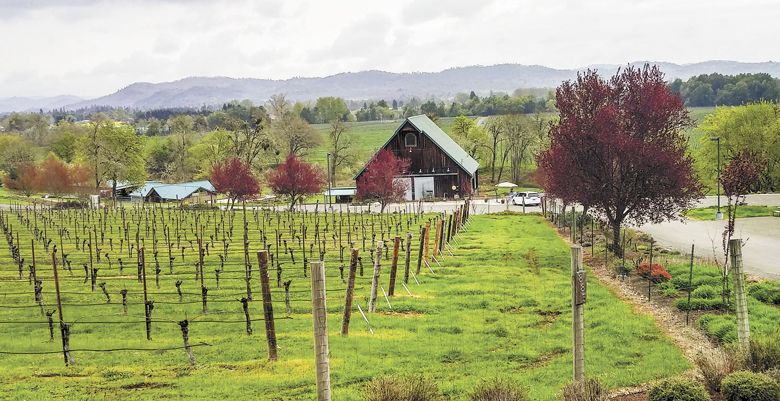Listen, All Y’all, It’s Pinotage
Melrose Vineyards muscles up a beastie wine
The Changeup by Michael Alberty
This is the story of a farmer swept off his feet in Las Vegas. It’s a familiar tale, except in this case, the object of affection was a grape. Pinotage is its name, and Wayne Parker of Melrose Vineyards never knew what hit him.
Wayne traveled to Las Vegas to watch his son, Cody, participate in the qualifying trials for the U.S. 2004 Olympic wrestling team. At dinner one night, Cody suggested buying an unfamiliar bottle of wine: South African Pinotage. “It was the most unusual wine I have ever tasted,” Parker says. “Every glass we poured was different from the last. We ordered another bottle and had the same experience.”
Unable to forget his one-night Vegas rendezvous with Pinotage, Wayne searched for vine cuttings to plant in his vineyard outside Roseburg. “I finally tracked down cuttings in Durban, South Africa, but that’s another story,” says Wayne, an imposing, powerfully built man, so I decided to let him tell the story any way he preferred.

Currently, Parker cultivates two acres of Pinotage on his Umpqua Valley property, enough to produce 150 cases in 2016. The winery’s first vintage of Pinotage came in 2008. In 2012, Cody took the reins as lead winemaker; Wayne retains the title of winegrower.
The only other Oregon Pinotage I know is an acre planted near Medford almost two decades ago by Traute and Don Moore of Quail Run Vineyards. According to Michael Moore, Quail Run’s general manager, the family sells their Pinotage grapes to small producers in California and Oregon, but every three years they make a Pinotage to sell at their tasting room.
This Southern Oregon enthusiasm for Pinotage hasn’t always been shared by the rest of the world, not even its ancestral home.
Pinotage was the creation of South African viticulturalist Abraham Izak Perold. He wanted Pinot Noir to have a fighting chance to succeed in South Africa’s warm climate, so in 1925, he crossed it with the “rough around the edges” pride of the Languedoc: Cinsault. The cross was successful, but Perold moved on to new projects. It wasn’t until his colleague, C.J. Theron, started grafting vines that Pinotage was ready to make into wine.

Cinsault was known at the time in South Africa as Hermitage, and written accounts suggest Theron and Perold considered naming the Pinot Noir-Cinsault cross Herminoir or Herminot. Thankfully, the name Pinotage won the day — over the Harry Potter-esque options.
When Pinotage wines appeared in the South African marketplace in the 1940s, the reaction was hostile. A combination of vines infected with leafroll virus, overcropping, picking grapes before they ripened properly and too much new French oak led to dense red wines with aromas and flavors of nail polish, burnt rubber and dirt. Afrikaaners began describing the wines with the word “dikvoet,” which roughly translates to “big feet.” It is not clear whether they were referring to Pinotage’s mouthfeel or its bouquet.
Those harsh sentiments never subsided over the decades. In 1997, famed Vergelegen winemaker André van Rensburg offered the following warning to aspiring South African winemakers: “Don’t steal, rape or murder — or make Pinotage.”
Fortunately, the Parkers don’t face the same challenges with Pinotage in Southern Oregon. “We find Pinotage farms like Pinot Noir, but we do have to drop more fruit, and it requires a bit more grooming during the growing season,” Wayne says. After tasting my first Melrose Vineyard Pinotage, I can promise you the beautiful wine defies the grape’s bad rap.
The 2016 Melrose Vineyard Pinotage ($28) has a dark magenta color an eyelash away from fading to black. The aromatics reminded me of a piece of white chalk dipped in blackberry juice, with a touch of violets floating around the background.
After a few sips, the wine’s tannins fuzzed up my teeth as flavors of black cherry, quince, leather and star anise coated my mouth. It says 14% alcohol on the label, but this wine is balanced and nimble on its feet. I appreciate the fact Cody used neutral French oak barrels to age this wine for six months and then held the wine in bottle for a couple of years at the winery.
Wayne fell in love with Pinotage because of the way it evolved in his glass. I revisited this wine the next day and found a different personality that smelled and tasted of grilled meat, espresso, thyme and black currants. It reminded me of a great GSM (Grenache-Syrah-Mourvèdre) from the southern Rhône. If you have the patience, I highly recommend allowing the Melrose Pinotage to stall and unleash its inner beast.
The Changeup is a baseball pitch designed to disorient and confuse. It’s the perfect representation of the unknown and its mastery over those who think they know what to expect. This column is devoted to those unorthodox Oregon wines you never saw coming.













